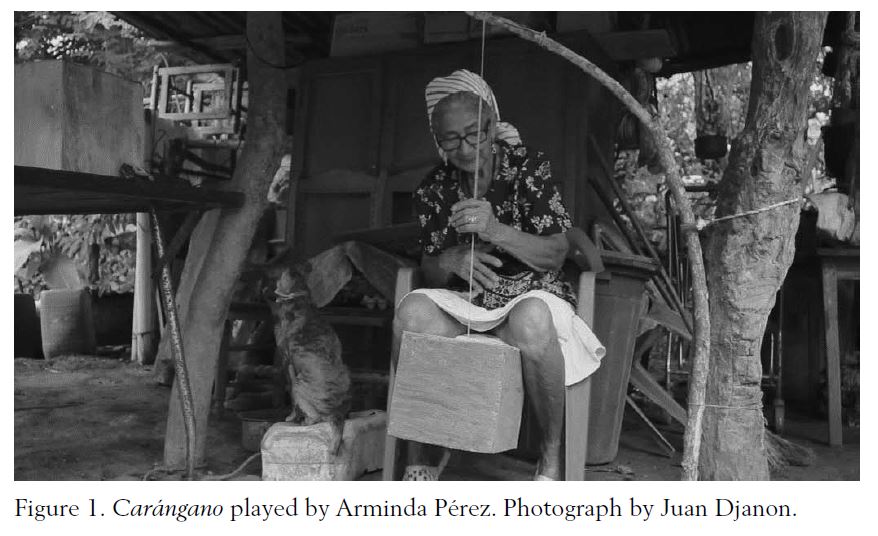CARÁNGANO AND WOMEN: STORY OF AN INSTRUMENT THREATENED WITH EXTINCTION
DOI:
https://doi.org/10.21504/amj.v11i1.2290Keywords:
Colombian Caribbean region, Ground bow, Women, Intangible cultural heritage, Trans-Atlantic, CaránganoAbstract
This article describes the results of an ethnomusicological study on the carángano, a ground bow instrument played only by women in the small villages of the Colombia Caribbean region. Before the introduction of electricity, the inhabitants contemplated the full moon as the women played, danced and laughed to the sound of this instrument. This instrument is now almost extinct. In this article, the social function, organological structure and repertoire of this instrument are analysed. The relationship between the carángano and other ground bows such as the tingo-talango or the dumbu-kalinga and sekituleghe on the American and African continents is discussed. These musical practices require urgent attention since they harbour musical and identification values belonging to the Colombian Caribbean region while sharing cultural aspects which connect Africans and African descendants across vast distances.
References
Babey, Francis 1975 African Music: A People’s Art. New York: Lawrence Hill Books. Bermúdez, Egberto 1985 Los Instrumentos Musicales en Colombia. Bogotá: Universidad Nacional de Colombia.
Bithell, Caroline and Hill, Juniper 2015 The Oxford Handbook of Music Revival. New York: Oxford University Press.
Camacho, Francisco 2011 “La Tina, Instrumento Típico de México?” Antropología, Boletín Oficial Instituto Nacional de Antropología e Historia 91: 150–55. https://revistas.inah.gob.mx/index.php/antropologia/article/view/2754 [Accessed on 17 January 2019].
Cassiani, Julio Cesar 2019 San Basilio de Palenque: Tradición y Libertad. Barranquilla: (unpublished).
Cuevas, Julio n.d “Tingo Talango Son.” Ritmocuba: http://www.ritmacuba.com/tingo-talango.html [Accessed on 28 January 2019].
Dargie, Dave 2016 “The Wonderful World of Southern African Musical Bows.” Paper presented at the First Bow Music Conference, Durban, South Africa, UKZN, February 24-27. http://www.bowconference.com/speakers-1/dave-dargie [Accessed on 23 July 2018].
Djenda, Maurice 1968 “L’arc-En-Terre Des Gbaya-Bokoto.” African Music 4 (2): 44-46.
Ekwueme, L.E.N. 1975 “Structural Levels of Rhythm and Form in African Music: With particular Reference to the West Coast.” African Music 5 (4): 27-35 https://doi.org/10.21504/amj.v5i4.1615 [Accessed on 11 June 2018].
Escamilla, Julio 1986 “Acerca de Los Orígenes y Características Del Habla Costeña.” Amauta 8: 81.
Evans, David 1970 “Afro-American One Stringed Instruments.” Western Folklore 29 (4): 22 9-45. https://doi.org/10.2307/1499045 [Accessed on 14 November 2018].
Fals Borda, Orlando 2002 Historia Doble de La Costa, IV. 2da ed. Bogotá: Universidad Nacional de Colombia. Banco de la República. El Ancora Editores. http://bdigital.unal.edu.co/1402/3/01PREL01.pdf [Accessed on 1 May 2018].
Johnston, Thomas F. 1987 “Shangana-Tsonga Drum and Bow Rhythms.” African Music 5 (1): 59–72.
Kruger, Jaco 1989 “Rediscovering the Venda Ground-Bow.” Ethnomusicology 33 (3): 391–404.
Kyker, Jennifer 2019 “Kambuya-Mbuya - Sekuru’s Stories.” Sekuru´s Stories: http://kyker. digitalscholar.rochester.edu/kambuya-mbuya/ [Accessed on 28 January 2 019].
Kubik, Gerhard 1962 “The Phenomenon of Inherent Rhythms in East and Central African Instrumental Music.” African Music 3 (1): 33-42.
Lawergren, Bo 1988 “The Origin of Musical Instruments and Sounds.” Anthropos 83 (1): 31-45.
List, George 2012 Música y Poesía En Un Pueblo Colombiano: Una Herencia Tri-Cultural. Vol.2. Bogotá: Patronato Colombiano de Artes y Ciencias.
Lenzerini, Federico 2011 “Intangible Cultural Heritage: The Living Culture of Peoples.” The European Journal of International Law 22 (1): 101–120.
Méndez, José E. 2010 “Gayumba, Balsié, Mangulina y Carabiné.” Identidad Sanjuanera: http:// identidadsanjuanera.blogspot.com.co/2010/07/gayumba-balsiemangulina- y-carabine.html [Accessed on 27 February 2017].
Novas, José 2014 “La Extinción de La Gayumba.” almomento.net: http://almomento.net/ la-extincion-de-la-gayumba/46991 [Accessed on 27 February 2017]. 27
Ortega, Carmen 1971 “Analogías y Simbolismos Botánicos y Zoológicos En el Lenguaje Popular Colombiano.” Revista de la Universidad Nacional 8: 26–67. https:// revistas.unal.edu.co/index.php/revistaun/article/viewFile/11937/12561 [Accessed on 4 March 2018].
Perdomo, José Ignacio 1980 Historia de La Música En Colombia, 5ta ed. Bogotá: Plaza & Janes. Pérez de Arce, José and Gili Francisca
Perdomo, José Ignacio 2013 “Clasificación Sachs-Hornbostel de Instrumentos Musicales: Una Revisión y Aplicación Desde La Perspectiva Americana.” Revista Musical Chilena 219: 42–80.
Pérez de Cuellar, Javier 1996 Our Creative Diversity: Report of the World Commission on Culture and Development. https://unesdoc.unesco.org/ark:/48223/ pf0000105586_spa [Accessed on 16 August 2019].
Pérez, Manuel A. 2009 Son de Pajarito. Colombia: TeleCaribe.
De Oliveira Pinto, Tiago 2008 ‘Crossed Rhythms’: African Structures, Brazilian Practices, and Afro- Brazilian Meanings.” AfricAmericas: Itineraries, Dialogues, and Sounds, (119): 165-180.
Royal Museum for Central Africa 2006 “Ground Bow.” DEKKMMA: http://music.africamuseum.be/instruments/ english/congo drc/nkutu_kubidi.html [Accessed 11 January 2017].
Tessmann, Günter 2007 Los Pamues, los fang: Monografía Etnológica de una Rama de las Tribus Negras del África Occidental. José Manuel Pedrosa, ed. Erika Reuss Galindo (tras.) Madrid: Ministerio de Asuntos Exteriores. https://estudiosafrohispanicos.wordpress.com/2015/01/16/cuadernos-deestudios- africanos-1948-1957-digitalizado/ [Accessed on 20 July 2019].
Trujillo Andrea, Genes Guido, Marín Angela and Cassiani Julio Cesar 2014 “El Carángano del Municipio de San Antonio de Palmito.” Barranquilla: Acta Universitatis Corporación Universitaria Reformada. Undergraduate Long Essay.
UNESCO 2018 Basic Texts of the 2003 Convention for the Safeguarding of the Intangible Cultural Heritage. https://doi.org/10.1093/rsq/9.4.70 [Accessed on 7 July 2019
Valencia, Victoriano 2004 Pitos y Tambores: Cartilla de Iniciación Musical. Ministerio de Cultura: http://www.mincultura.gov.co/proyectoeditorial/Documentos Publicaciones/Pitos y Tambores/Pitos y TamboresWeb.pdf [Accessed on 12 July 2019].
Varona, Arnoldo 2015 “What is the Tíngo Talángo?” Cubanism: http://www.thecubanhistory.com/2015/05/cubanism-whatis- the-tingo-talango-cubanismos-que-es-el-tingo-talango [Accessed on 28 January 2019].
Ziegler, Susanne 2006 Die Wachszylinder des Berliner Phonogramm-Archivs, Vol. 12. Germany: Staatliche Museen zu Berlin.
Interviews by Author
Cultural Leader. (San Antonio de Palmito, Colombia), 28-30 September 2014.
Pérez, Arminda. (San Antonio de Palmito, Colombia), 28-30 September 2014.
Mamatsharaga, Mtumbateka. (Thohoyandou, South Africa), 7-10 September 2018.
Nanyungwe, Sarah Kyasooka. (Kampala, Uganda), 13 September 2018.




